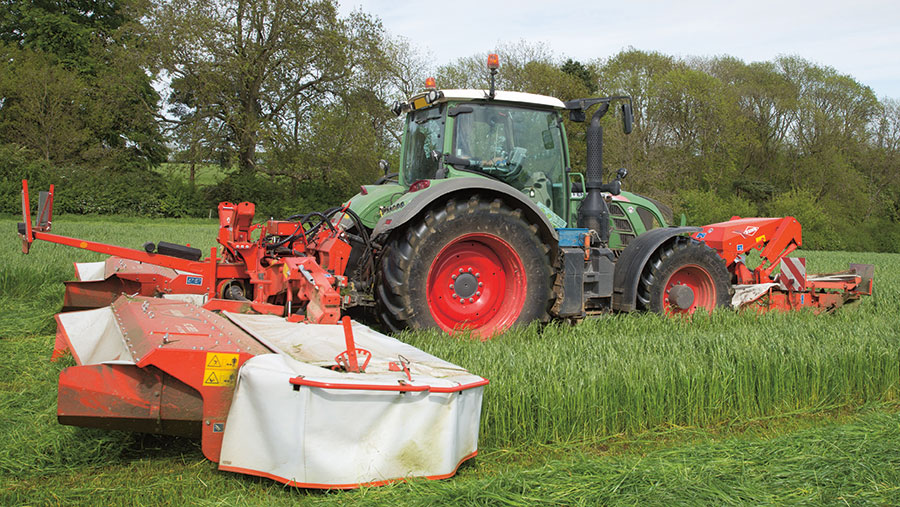Q&A: Understanding the lactic acid concentration in your silage
 Silage should be mowed and wilted rapidly © Tim Scrivener
Silage should be mowed and wilted rapidly © Tim Scrivener There is massive confusion and misunderstanding about lactic acid and its role in silage fermentation and effect on cow performance.
Independent expert Dave Davies of Silage Solutions sets the record straight.
Q1. What is lactic acid, and what effect does it have on crop fermentation?
Contrary to widespread belief, lactic acid in silage is a very good thing because it helps preserve the forage.
The level of lactic acid in your silage is dominated, not by which additive you use but, by the dry matter (DM) of the crop at harvest.
The only way to reduce lactic acid concentration in your silage without having a negative effect on silage quality is to increase the dry matter through wilting, although this isn’t always possible.
See also: Guide to assessing your silage clamp for costly losses
UK farm analyses (over 500 in total) conducted on behalf of Promar in 2015 show as DM increases the level of lactic acid decreases (see figure 1 below).
However, the wetter silages, within a given DM, have a higher degree of variability in the lactic acid content.
Looking at the data in figure 1b representing the total acid (lactic plus all the volatile fatty acids – VFAs), the same trend is visible.
However, at the lower DM end there is less variability between samples of the same DM than shown in the previous figure.
This is because a silage with a high level of lactic acid at a given DM will have a lower concentration of VFA, and vice versa.
Low DM silages contain more liquid and it is the concentration of acid in the liquid phase that controls the fermentation, so wet silages need more acid for fermentation.
Lactic acid is a stronger acid than acetic and so this controls the fermentation quicker. So lactic acid is good.
Q2. What limits the intake of lower DM silage?
The DM and undigestible fibre content of a silage are the first parameters that reduce DM intake. It’s not the lactic acid content but the DM that limits the intake of wet silage.
The lower DM silages contain a lot of water so the rumen cannot physically fit as much silage in as a higher DM silage.
Q3. What effect do different additives have on the pH and acid content of silage?
Good, rapid producers of lactic acid are essential to produce a good fermented silage. Quick silage fermentation and lactic acid production during ensiling stops enzymes from breaking down the protein in silage and buffers the pH decline.
Q4. Is lactic acid a good thing or a bad thing for the ruminant?
Lactic acid in the rumen is not necessarily a bad thing. In fact, it is more dependent of why it is there.
If it’s due to a rapid starch fermentation due to an unbalanced ration or poor TMR mixing then it can be detrimental, but if it is being consumed in silage then it may even be beneficial.
The graphs below show the results of a trial at Teagasc in Ireland. The same grass was ensiled with a range of different additives, giving a huge range in final pHs from 3.6 to 4.1.
However, when these were fed, the rumen pH only fluctuated from 6.66 to 6.7. This shows the silage pH, and therefore lactic acid content, has absolutely no effect on the rumen pH and acidosis, which is contrary to what many in the industry tell you.
Finally, in the evidence for the beneficial effects of lactic acid in silage on the animal, the table below shows the results of some Swedish work where sugar, lactic acid or a mixture of the two were fed and the rumen pH and propionic acid levels produced were observed,
Propionic acid is an end product of starch and sugar fermentation.
Those animals fed sugar had significantly lower pH and less rumen propionate, whereas the lactic acid fed livestock had a higher rumen pH and more propionate.
This is not a bad thing because this will help maintain a higher population of rumen bacteria able to use lactic acid.
Also, if too little propionate is produced, which can occur during the feeding of high-fibre diets, the synthesis of milk lactose and overall milk yield is reduced.
To compensate for the energy deficit caused by insufficient propionate, body fat is mobilised and the cow loses body condition.
So, in summary, lactic acid in silage is good. The optimal DM of grass clamped silage is 30-32%, but this should be achieved by wilting rapidly and for no longer than 36 hours.
Mow with a mower conditioner and spread the crop immediately.
At this DM the final pH should be around 4, with a total acid (lactic + VFA) content ranging from 80-130g/kg DM. Lower DM crops will have a lower pH and more acid and higher DM crops a higher pH with lower acid content.
